
Starter Kill
OK, there is the conventional starter kill and then
there's my starter kill :-)
First off, I'll tell you about the conventional
starter kill.
Most of the starter kills are "neat" in the
way they function and are very reliable. Starter kill circuits use standard
automotive relays. What I mean by "neat" is normally you would think of a
relay as being either energized or de-energized i.e., when the alarm is activated the
relay is energized and when the alarm is de-activated, the relay is de-energized (or
vice-versa). If this were the case, the failures of alarm starter kill relays would
probably be much higher because this relay would be energized say 1/2 the time.
This could also cause your battery to go dead if you let the car set for extended period
of time due to the small current draw by the relay when activated. Well, this is not
at all how they work. Study the diagram below.
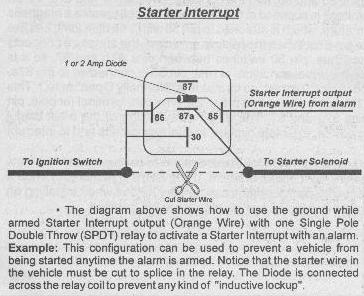
If you read my main alarm installation page and
learned anything from it, you'll see exactly what the above relay configuration is doing
for you :) But, if you didn't, I'll try to explain it. Pins 85 and 86 are for
the coil. The starter interrupt output from the alarm is connected to pin 85.
This wire from the alarm is nothing more than a ground signal whenever the alarm is armed
and an open when it is not armed. Pin 87a goes to the starter and is where the
relay's armature rests when the relay is de-energized... the electrical path is completed
from pin 30 to 87a when the relay's coil is de-energized. Now, instead of supplying
a constant 12v to the other side of the relay, you'll notice that this 12v supply is
coming from the ignition switch. Since this is the actual starter wire, it is only
getting 12v when the key is turned to the start position. So, with the alarm
disarmed, if the key is turned to the start position, the relay doesn't actuate because
there is no ground from the alarm (alarm disarmed). But, if the alarm is armed, and
the key is turned to the start position, the starter wire will get 12v up to the point of
the relay. When this happens the relay will actuate (since a ground is being
supplied by the alarm to the other side of the coil) and will "pull" the
armature of the relay to pin 87 and thus breaking the starter's 12v circuit from pin 30 to
pin 87a and not allow any "juice" to go to the starter. With this type of
relay configuration, the only time the relay will be actuated is when someone tries to
start the car with the alarm armed... which should be NEVER! :) Because of this
design, starter interrupt relay failures are basically nonexistent.
To connect this up to your F-Body, it seems most
install books reference using a YELLOW wire at the ignition
switch. Well, since most alarm installers connect the starter kill here, this is
exactly what the thief is expecting and looking for. I happen to have a factory
service manual for the 96 F-Body and have found a much better place for this connection :)
I prefer to use a PURPLE wire which is downstream of
the theft deterrent relay. This wire is in an unsuspecting location on the passenger
side right before it goes through the firewall and is difficult to get to. A perfect
place! What makes this even better is that you already have the car torn apart to
the point it needs to be to get to this wire! If you remember above from the hatch
release, this theft deterrent relay is right above the hatch release relay in the glove
box area. See picture below.
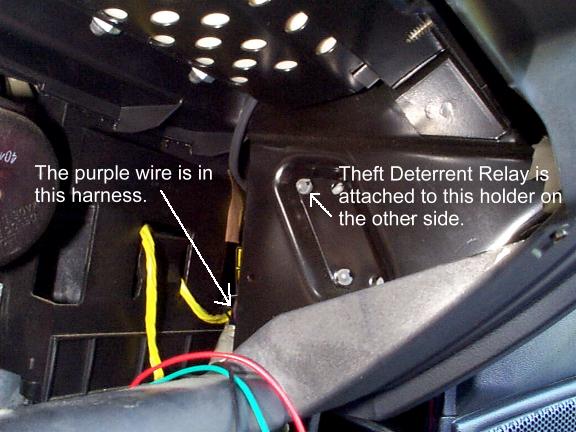
Theft Deterrent Relay Location
Now that you've found the relay you're probably
noticing that it is a pretty tight working area back there. Never fear, there is a
better place to cut the PURPLE wire and make your
connections. See picture below.
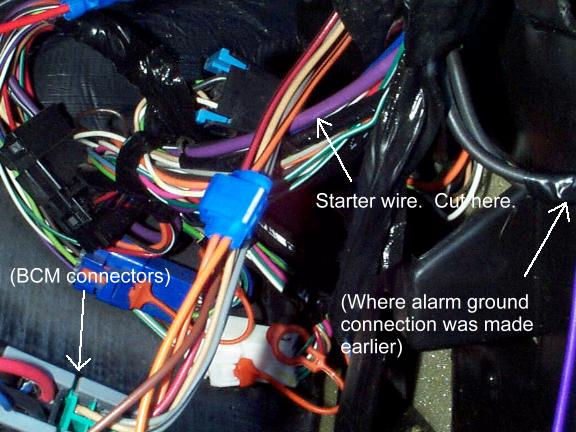
Purple Starter Wire
OK, now that I've described how to do the
conventional starter kill, I'm going to show you my way to do the starter kill. If
you think about it, if the thief can disable your alarm, and can get by the PASS Key
protection (which some can) then he has the ability to start your car. Many of the
high tech thieves use code grabbers that can actually intercept the frequency of your
transmitter (if you have an alarm). They'll then use their "special
device" to disarm your alarm when you walk away from the car. Say bye bye to
the F-bod. What I've done is installed a starter kill type circuit which is
completely separate from the alarm system. It is stand alone and does not need the
alarm system. It is extremely simple yet extremely effective. This works on
the complete opposite theory of the conventional starter kill I described above. I
still use the same PURPLE wire (much better IMO than the YELLOW wire at the ignition switch!) but in my circuit the only
time the circuit to the starter is completed is when I want it to be.
Here is how it works... when you get in my car
and turn the key to the start position, nothing happens. It doesn't matter if the
alarm is disarmed or even if you have the right/wrong key... nothing will happen period.
In order to start my car, I must hold the driver side passenger window switch in
the UP position WHILE turning the key to start the car :-) I decided to use this
particular switch for a few reasons 1) I didn't want an extra switch which appeared
out of place or suspicious 2) I needed a switch that I could access with my left hand
while turning the key with my right and 3) The connection for this wire is right near our PURPLE wire!
What this does is activates a separate relay I
installed any time the passenger window switch from the driver side is pressed in the UP
position and there is power available to the accessories. What this also means is
that the relay won't be made up unless the key is turned to the ON position even if the
switch is held in the correct position. We're talking multi levels of protection
here. So basically, if anyone ever steals my car, it has to be one of my friends or
one of you guys reading this page :-) The chances of somebody getting by 1) my alarm
system 2) the PASS Key II system and 3) my super secret window start is highly unlikely :)
You're probably thinking right now that this relay
will be made up whenever you roll up your passenger side window. Well, you'd be
correct, but so what? :) All that is happening is the relay is being made up.
There is no power being sent through the relay (except for the coil, of course) because
you're not holding the key to the start position.
About the only extra thing you need to know in
addition to the above conventional starter kill information is the location of the correct
wire for the passenger side window roll-up. This wire is a LIGHT
BLUE wire and can be found in the wiring harness just before this grouping of wires
exits the car and goes into the door. This is pretty much a pain to make this
connection but isn't too difficult if you use a blue quick splice connector.
Pictured below is the wire you'll need to connect to if you choose to do this type of
starter kill.
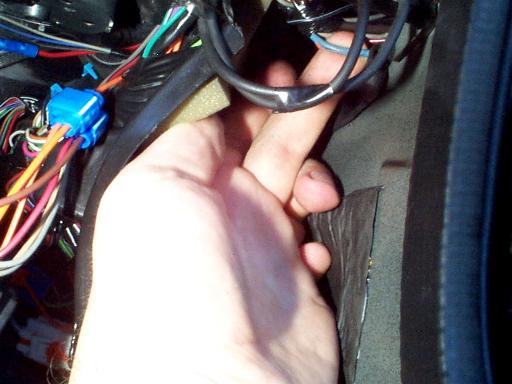
Passenger side window UP wire location
Once you make this connection with a piece of
"spare" wire, we're ready to make the rest of the connections to the relay.
Go ahead and cut the PURPLE wire as described above in
the conventional starter kill section. For this starter kill I just used a regular
starter kill relay harness (pictured below) and modified it slightly by snipping the red
"loop" since we want the 12v that powers the coil (window up 12v) to be
different than the 12v coming from the ignition switch and also by taking the white wire
shown below and moving it from its center location (87a) to the blank left slot
(87). How necessary is the diode? I don't really know. I'm sure it's
there just as a precaution. If you don't have a harness like this, you can use
regular female type blade connectors (like what would slide over a speaker connection) and
slide them over the individual relay posts. These can be found at Radio Shack or
even Wal-Mart. The diode you'll probably have to pick up from Radio Shack.
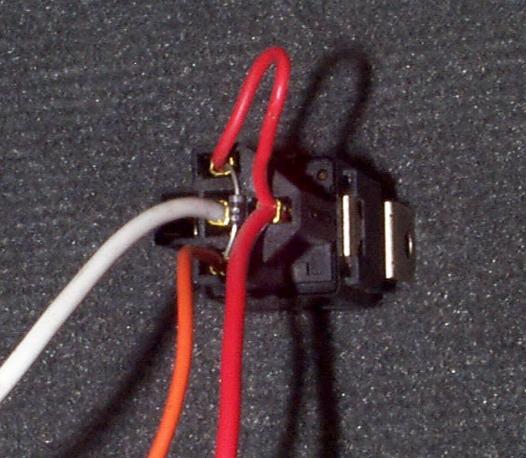
NOTE: The following will describe connecting
wires to the relay pins based on the above picture of the relay harness that I used.
This picture is different than the scanned in diagram near the top of this page!
The coil pins (85 and 86) are "swapped." By that I mean the diagram
shows pin 86 being 12v whereas I have pin 86 being a ground and pin 85 being a ground
where I hook it up to 12v. This is OK so long as you get the orientation of the
diode correct... the banded side must point towards the 12v side, regardless of which pin
you use for 12v. Don't let this confuse you. Either follow the diagram at the
top or the below paragraph but don't try to combine the two because you will get confused!
:)
You'll be making your connections as follows (don't forget that I moved the center wire to
the left): For the coil, we want one side to be grounded all the time so connect pin
86 to your ground, which would be the ORANGE wire
above. We want the coil to be actuated whenever we press the UP window switch so
connect the wire you just spliced into the LIGHT BLUE window
motor wire to the other side of the coil, pin 85. In my case, pin 85 is the single
side of the RED looped wire... which I snipped in half and
just taped the small RED wire to the larger RED wire so it's out of the way. Now that the coil
connections are made, it's time to connect the starter wires. Since this harness is
actually designed to be a starter kill, the non-looped RED
and WHITE wires above are a larger gauge wire to handle the large current draw of the
starter. If you are making up your own connectors with your own wire and don't have
a harness like I do, you need to keep this in mind! These wires should be at least
14 gauge and preferably 12 gauge... don't be trying to use no telephone wire to do this!!!
:) OK, I connected the Theft Deterrent Relay side of the PURPLE
wire to the larger RED wire above on pin 30. The
starter side of the PURPLE wire gets connected to the WHITE
wire on pin 87 (remember, I moved it after I took the above picture). When you
are finished, it will look something like the picture below. Notice the cut PURPLE wire in the background.
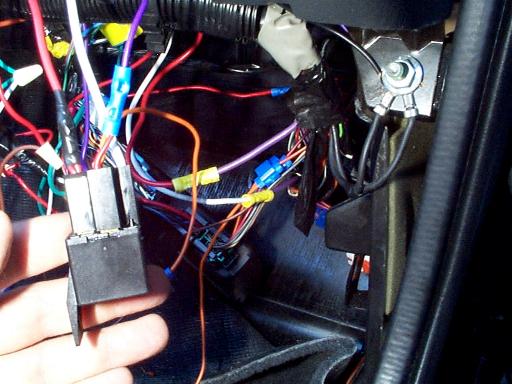
Brent's Starter Kill.
(Note: The purple wire going to the relay has nothing to do with the purple starter
wires. The purple wire going to the relay is what comes from the light blue wire
splice. I should have used a different colored wire to avoid confusion but I didn't
:)
The more I think about this type of starter kill, I
believe it to probably be more effective at preventing your car from being stolen than the
entire rest of the alarm system combined. The nice thing about this is that you can
get protection like this for under $5 (the cost of the relay and a few connectors) and all
you have to do have is a little mechanical skill and be able to follow the instructions I
have above. I don't know how many people actually do "weird" and different
type stuff like this, but I welcome your comments. Send me some email if you've done
an "off the wall" install like this and tell me about it!
bfranker@tampabay.rr.com
 |